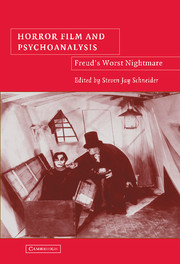Book contents
- Frontmatter
- Contents
- Acknowledgments
- Foreword: “What Lies Beneath?”
- Introduction: “Psychoanalysis in/and/of the Horror Film”
- PART ONE THE QUESTION OF HORROR-PLEASURE
- PART TWO THEORIZING THE UNCANNY
- 5 Explaining the Uncanny in The Double Life of Véronique
- 6 Manifestations of the Literary Double in Modern Horror Cinema
- 7 Heimlich Maneuvres: On a Certain Tendency of Horror and Speculative Cinema
- 8 “It was a dark and stormy night…”: Horror Films and the Problem of Irony
- PART THREE REPRESENTING PSYCHOANALYSIS
- PART FOUR NEW DIRECTIONS
- Afterword: Psychoanalysis and the Horror Film
- About the Contributors
- Bibliography
- Index
8 - “It was a dark and stormy night…”: Horror Films and the Problem of Irony
Published online by Cambridge University Press: 14 July 2009
- Frontmatter
- Contents
- Acknowledgments
- Foreword: “What Lies Beneath?”
- Introduction: “Psychoanalysis in/and/of the Horror Film”
- PART ONE THE QUESTION OF HORROR-PLEASURE
- PART TWO THEORIZING THE UNCANNY
- 5 Explaining the Uncanny in The Double Life of Véronique
- 6 Manifestations of the Literary Double in Modern Horror Cinema
- 7 Heimlich Maneuvres: On a Certain Tendency of Horror and Speculative Cinema
- 8 “It was a dark and stormy night…”: Horror Films and the Problem of Irony
- PART THREE REPRESENTING PSYCHOANALYSIS
- PART FOUR NEW DIRECTIONS
- Afterword: Psychoanalysis and the Horror Film
- About the Contributors
- Bibliography
- Index
Summary
John Carpenter's f/x heavy remake of The Thing (1982) contains a brief interaction between man and monster that graphically foregrounds the chief problematic of the horror film. Under attack from a shape-shifting parasite that readily jumps from species to species and host to host, the members of an Arctic research team attempt to hold their own. In a rare moment of human advantage, the beleaguered company manages to temporarily isolate the chameleon invader. Sequestered in the host head of a decapitated human, the parasite seeks escape by morphing into a hermit-crab-and-skull combination that scuttles to freedom on scaly legs. As the beast of fusion skitters away, a gape-jawed, goggle-eyed technician exclaims, “You gotta be fucking kidding!”
Composed in equal measure of ontological and epistemological bewilderment, this profane cry exactly delimits the boundaries of the genre. Bound between what can and cannot be, the astonished prole must decide between exclusive options. Is the crab head that once crowned a colleague's body a macabre joke, eyes playing tricks, or is the foul crustacean an oracle? Cast between the antipodes of raillery and revelation, the lab tech and his double, the protagonist and the audience must decide if seeing is truly believing. Over and again, The Thing and others of its ilk call for a response. Horror is then an interrogative genre that demands of its subjects, on screen and off, a reply. Is this some kind of joke?
- Type
- Chapter
- Information
- Horror Film and PsychoanalysisFreud's Worst Nightmare, pp. 142 - 156Publisher: Cambridge University PressPrint publication year: 2004
- 1
- Cited by



